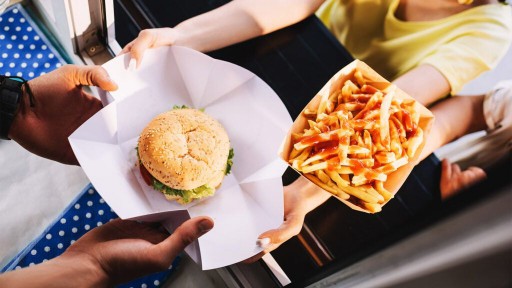- Food sequencing refers to the order in which different foods are consumed during a meal.
- Some experts advise eating vegetables, followed by proteins and healthy fats, then finishing your meal with carbohydrates.
- Experts recommend patients focus on the ratios of food on their plates before worrying too much about what order they eat it in.
Does eating one type of food before another make a difference on your health?
Also known as food sequencing (or meal sequencing), some wellness influencers and nutrition experts are making a case for eating certain foods before others.
TikTok videos circulating the internet claim that this “ordering” of food can help you stop unnecessary snacking, curb cravings, and even help reduce symptoms of PCOS.
Many of these claimed benefits revolve around blood sugar levels, and how certain foods can elevate your blood sugar more dramatically depending on what food comes before or after them.
While there is no hard-and-fast rule when it comes to the recommended order of foods to eat, the following order is fairly common: raw or cooked vegetables, proteins and healthy fats, and lastly, carbohydrates.
Here’s what registered dietitians have to say about food sequencing and its benefits, as well as if it’s really worth adopting to your own nutrition habits.

Getty Images / Kilito Chan
The Link Between Blood Sugar Control and Food Sequencing
While social media claims should always be taken lightly, the idea that the order you eat your food in is linked to your blood sugar actually has some merit.
By eating fat and protein before carbohydrates, as is recommended by most people practicing food sequencing, you may experience a greater feeling of satiety.
Specifically, eating these macros before carbohydrates can help promote the secretion of a hormone called glucagon-like peptide-1 (GLP-1), which, among other effects, can help delay gastric emptying and improve post-meal glucose (blood sugar) management.
This can help you feel full for a longer period of time, prevent overeating, and help curb cravings.
In addition to protein and healthy fats, eating fiber before carbohydrate intake (like what you get by eating vegetables) significantly reduces post-meal glucose increases—AKA, blood sugar spikes.
A 2022 study evaluated how eating vegetables before carbohydrates impacted blood sugar among people with type 2 diabetes. Results showed a significant improvement in hemoglobin A1C (average blood sugar levels within the last three months) after five years of participants following the eating pattern.
While this data makes a case for food sequencing's impact on overall blood sugar control, more is still needed to confirm its clinical validity.
A 2022 systematic review of eight trials found that people with type 2 diabetes who practiced meal sequencing experienced little to no difference among hemoglobin A1C, plasma glucose, plasma insulin, and plasma GLP-1 when compared with those who did not follow meal sequencing.
The authors of that review concluded that there was no strong evidence for the potential benefit of recommending meal sequencing beyond standard dietary advice on type 2 diabetes.
So, while food sequencing has the potential to be helpful, it’s not a guaranteed way to manage your blood sugar levels.
Why Blood Sugar Can Get Too Low—And What to Do About It
Practical Tips For Blood Sugar Management
Whether by food sequencing or another method, experts stress the importance of maintaining blood sugar levels for the sake of long-term well-being.
“Blood sugar control matters to help prevent long-term complications,” Mary Ellen Phipps, MPH, RDN, LD, registered dietitian nutritionist and author of The Easy Diabetes Cookbook, told Health.
While more data is needed to confirm the impact of food sequencing on people with diabetes, Phipps explained that individuals who are at high risk for developing diabetes, or people who’ve already been diagnosed with pre-diabetes or diabetes, should consider beginning their meals with non-starchy vegetables, then moving on to protein, then finishing with carbohydrates “to improve blood sugars after their meal.”
“When this happens, you’re more likely to snack on sweet stuff or overeat,” she said.
To effectively manage blood sugar levels, it’s crucial to adopt a well-rounded approach that includes diet, exercise, and lifestyle modifications. Some practical tips include:
- Follow a balanced diet: Prioritize a diet rich in fiber, lean proteins, and healthy fats over simple carbohydrates and sugars. Choose whole grains, lean meats, fruits, vegetables, and nuts.
- Include regular exercise: Physical activity can help your muscles use the sugar present in your blood, effectively lowering your blood sugar levels. Aim for at least 30 minutes of moderate activity most days of the week.
- Practice portion control: Even healthy foods can cause blood sugar spikes if eaten in large amounts. Try to maintain adequate portions at every meal.
- Incorporate regular monitoring: Keep track of your blood sugar levels regularly to understand how different foods, activities, and stress levels affect them.
- Enjoy scheduled meals: Try to eat your meals and snacks at the same times every day to help keep your blood sugar levels steady. Avoid skipping meals.
It’s also worth noting that other food habits—aside from food sequencing—can be just as important in maintaining a healthy blood sugar range.
Phillips suggests avoiding eating carbohydrates by themselves to avoid a blood sugar spike. “Pair your carbs with plant-based fats, proteins, and fiber,” she said.
Saucena added that it may be more important to be “concerned by the ratios of food on your plate versus the order you eat them in” for blood sugar control support. Having a combination of protein, fat, and fiber can help you “feel full, energized, and stabilize your blood sugar.”
But, ultimately, managing your blood sugar comes down to what works best for you and your body.
“Everyone is different and what works best for you may not work as well for others,” Phipps said. “It’s important to consult with a healthcare professional before making any significant changes to your diet or lifestyle.”
Foods That Will Keep You Full Without Spiking Your Blood Sugar





